When it comes to our beloved canine companions, their safety and well-being are of utmost importance. However, accidents happen, and if your dog ate ham bone, it’s essential to understand the potential risks and take appropriate action.
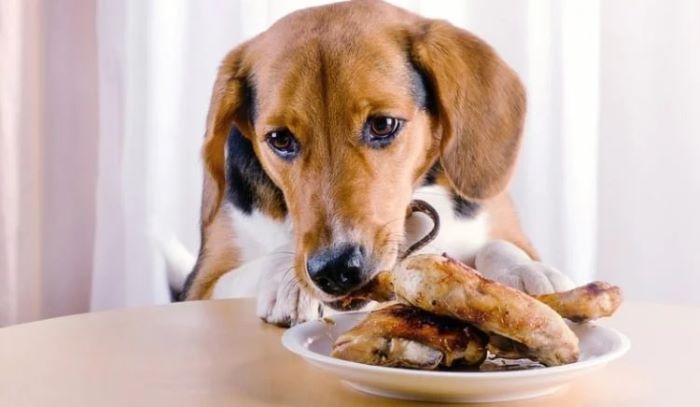
Ham bones can pose serious dangers to dogs, and knowing how to handle the situation can make all the difference in ensuring your furry friend’s health and happiness.
Contents
Why Ham Bones Are Dangerous for Dogs?
Ham bones may seem like a tasty treat for your dog, but they can pose serious risks to their health. Cooked ham bones can splinter into sharp pieces that can damage the dog’s mouth, throat, stomach, and intestines.
These pieces can cause injuries, infections, obstructions, and even perforations that can lead to internal bleeding and peritonitis.[1]

Symptoms of Ham Bone Ingestion in Dogs
If your dog has eaten a ham bone, you need to watch them closely for any signs of trouble. Some of the symptoms of ham bone ingestion include:
- Vomiting and diarrhea
- Blood in stool or vomit
- Loss of appetite or difficulty eating
- Lethargy or weakness
- Abdominal pain or swelling
- Trouble breathing or swallowing
These symptoms may appear within 24 to 72 hours after your dog eats a ham bone. If you notice any of these symptoms, you should contact your veterinarian immediately, as your dog may need urgent medical attention.
What to Do If Your Dog Ate a Ham Bone?
You might be concerned about the possible repercussions if your dog consumed a ham bone. Ham bones can be harmful to dogs[2] because they can splinter and create wounds, infections, or gastrointestinal blockages.
These actions can be taken to assist your dog if they ate a ham bone.

Monitor Your Dog for Any Signs of Distress or Discomfort
The first thing that you should do is to observe your dog closely for any signs of trouble. Some of the symptoms that may indicate a problem with ham bone ingestion are :
- Vomiting and diarrhea: These are common signs of gastrointestinal irritation or obstruction caused by the bone fragments. They can also lead to dehydration and electrolyte imbalance in your dog.
- Blood in stool or vomit: This is a serious sign of internal bleeding or perforation caused by the bone fragments. It can also indicate an infection or inflammation in your dog’s digestive system.
- Loss of appetite or difficulty eating: This can be a sign of pain, nausea, or obstruction caused by the bone fragments. It can also affect your dog’s nutrition and energy levels.
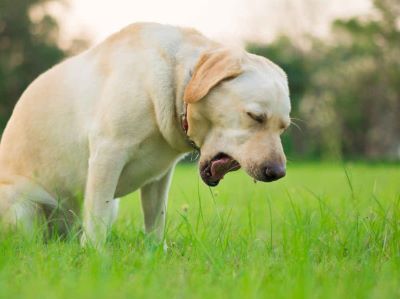
- Lethargy or weakness: This can be a sign of dehydration, infection, or shock caused by the bone fragments. It can also indicate a loss of blood or oxygen in your dog’s body.
- Abdominal pain or swelling: This can be a sign of inflammation, infection, or obstruction caused by the bone fragments. It can also indicate a buildup of gas or fluid in your dog’s abdomen.
- Trouble breathing or swallowing: This can be a sign of injury, infection, or obstruction caused by the bone fragments in your dog’s mouth, throat, or chest. It can also affect your dog’s oxygen intake and heart function.
These symptoms may appear within 24 to 72 hours after your dog eats a ham bone. If you notice any of these symptoms, you should contact your veterinarian immediately, as your dog may need urgent medical attention.
Try Some Home Remedies to Help Your Dog Pass the Bone Fragments
If your dog does not show any severe symptoms, you can try some home remedies to help them pass the bone fragments more easily. Some of the foods that you can give your dog are:

- Bread or mashed potatoes: These foods can bind to the bone fragments and act as a cushion to prevent damage to the intestinal tract.
- Water and high-fiber vegetables: These foods can help with digestion and hydration and facilitate the movement of the bone fragments through the digestive system.
However, these DIY solutions do not replace veterinarian treatment. Even so, if your dog doesn’t pass the bone within 24 hours or exhibits any indications of trouble or discomfort, you should keep an eye on them and take them to the doctor.
Seek Veterinary Attention As Soon As Possible
The most crucial action you should take if your dog ate a ham bone is to get medical help as soon as you can.
In order to ascertain the severity of the injury and the most appropriate course of therapy, your veterinarian can do a physical examination as well as diagnostic procedures like radiography, endoscopies, or blood tests.
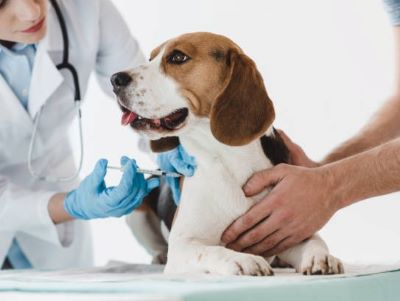
Your veterinarian may suggest one or more of the following treatment options depending on the circumstance:
- Endoscopy: To remove the bone pieces, a flexible tube with a camera and equipment is inserted into the dog’s mouth and stomach during this minimally invasive treatment.
- Surgery: This is a more invasive procedure that involves making an incision in the dog’s abdomen and manually removing the bone fragments from the stomach or intestines.
- Antibiotics: This is a medication that can help prevent or treat infections caused by the bone fragments.
- Fluid therapy: This is a treatment that involves giving fluids intravenously or subcutaneously to help with dehydration and electrolyte imbalance.
How to Prevent Your Dog From Eating Ham Bones?
Ham bones are not only dangerous for dogs, but also unnecessary. Dogs do not need ham bones or any cooked bones to satisfy their chewing needs or to get nutrients.
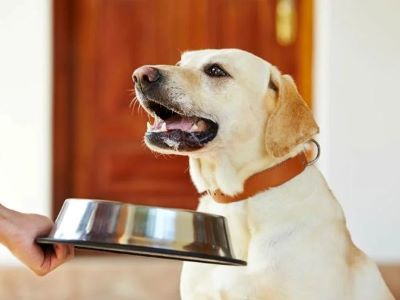
In fact, ham bones or any cooked bones can cause more harm than good to your dog’s health . Here are some tips on how to prevent your dog from eating ham bones.
Avoid Giving Ham Bones or Any Cooked Bones to Your Dog
The best way to prevent your dog from eating ham bones is to avoid giving them to your dog in the first place.
Ham bones or any cooked bones are not suitable for dogs, as they can splinter and cause injuries, infections, or obstructions in the dog’s digestive system.
You should also avoid leaving ham bones or any cooked bones in places where your dog can access them, such as the trash, the kitchen counter, or the dining table.
You should dispose of ham bones or any cooked bones in a secure way that your dog cannot reach.
Provide Safe and Healthy Alternatives for Your Dog
Instead of giving ham bones or any cooked bones to your dog, you should provide safe and healthy alternatives[3] that can satisfy your dog’s chewing needs and provide nutrients. Some of the alternatives that you can give your dog are:
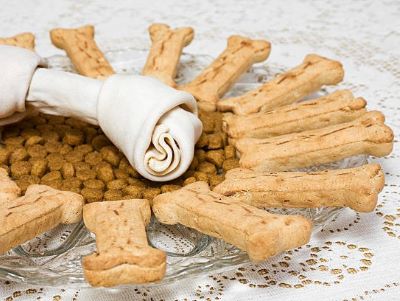
- Artificial bones: They are carefully created items that can endure your dog’s gnawing and are composed of strong, non-toxic materials. They are available in a variety of forms, proportions, and tastes to suit your dog’s preferences.
- Rawhide chews: These materials, which are composed of dried animal skin, may give your dog a long-lasting and natural chewing experience. Also, they might aid in maintaining oral hygiene and avoiding tartar formation.
- Other treats for dogs: They are goods that are created from organic materials and may offer your dog a delectable and wholesome treat. Also, they may assist with teaching and rewarding your dog for excellent behavior.
Supervise Your Dog When They Have Access to Bones or Other Potential Hazards
Even if you avoid giving ham bones or any cooked bones to your dog and provide safe and healthy alternatives, you should still supervise your dog when they have access to bones or other potential hazards.
You never know when your dog may encounter a ham bone or any cooked bone in someone else’s house, in the park, or on the street.
You should also be aware of other potential hazards that your dog may chew on, such as plastic, metal, wood, or plants. These items can also cause injuries, infections, or obstructions in your dog’s digestive system.
If you see your dog chewing on something that is not safe for them, you should intervene immediately and remove the item from their mouth.
You should also praise your dog for dropping the item and redirect their attention to something else.
FAQs
What happens if dog eats a ham bone?
Eating a ham bone can be dangerous for a dog, as it can splinter and cause damage and infection in the digestive system. The dog may need veterinary attention if it shows any signs of distress or discomfort.
Can a dog survive eating a ham bone?
A dog may survive eating a ham bone if it does not have any serious complications from it. However, most dogs will have some problems after eating a ham bone and may need veterinary care to recover.
What should I do if my dog ate ham?
Eating ham can cause digestive upset or pancreatitis in dogs. The dog should be monitored for any signs of illness or discomfort and taken to the veterinarian if needed.
Can ham make a dog sick?
Ham can make a dog sick if it is high in fat and salt and causes digestive upset or pancreatitis. The dog may need veterinary attention if it shows any signs of illness or discomfort.
Conclusion
In conclusion, if your dog ate a ham bone, it’s crucial to act swiftly and responsibly. Remember, ham bones are dangerous for dogs due to the risk of splintering, blockages, and injuries to the mouth or digestive tract.
Monitoring your dog for distress or discomfort, trying home remedies to help them pass the bone fragments, and seeking veterinary attention if needed are all important steps.
Prevention is key, so remember to avoid giving ham bones or cooked bones to your dog, provide safe alternatives, and supervise their access to potential hazards.
By prioritizing your dog’s well-being and taking appropriate measures, you can keep them happy, healthy, and safe from the dangers of ham bones.
References:
- Sykes, J. E. (2014b). Intra-abdominal infections. In Elsevier eBooks (pp. 859–870). – ScienceDirect
- No Bones About It: Bones are Unsafe for Your Dog. (n.d.). Retrieved July 19, 2023, from – City of Albuquerque
- Rknight. (2022, December 7). Feeding dogs healthy treats during the holidays. VMBS News. Retrieved July 19, 2023, from – Texas A&M University

Julia is a Board Certified Veterinary Nutritionist, practicing veterinarian in a non-profit animal hospital and feline sanctuary located in Rochester, NY. She is also a full-time veterinary advisor at DogLikesBest. She focuses on writing healthcare-related topics including dog foods, treats, veterinary diets, food for specific healthcare features, etc. Moreover, any article on DogNeedsBest that has to concern feline health in any way, goes under her scrutiny before being published.

